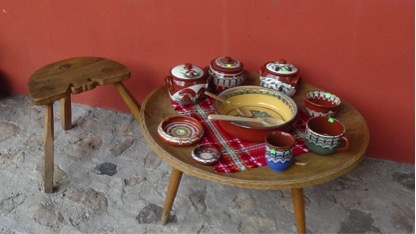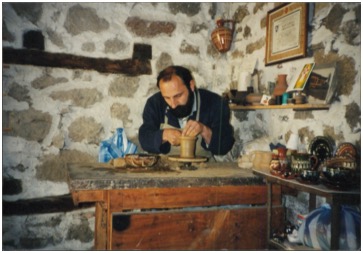Perhaps this title is a little too strong a statement. To be honest, this writer hasn’t seen much of the pottery of the other countries on the Balkan Peninsula. The Greeks, among others might disagree with this title and with good reason. But the point is, Bulgarian pottery has distinctive patterns that are beautiful. It is an art form there and a practical one as well. It’s quite a nice thing isn’t it, this art incorporated into everyday life?

A table filled with Bulgarian Pottery.
In the Bulgarian Tourist Promotion and Publicity Centre’s Bulgarian Folk Art it is noted that pottery might be the first Bulgarian craft. Samples of pieces from the First Bulgarian State, an historical period from the seventh to the twelfth centuries, already show aspects of the Bulgarian national pottery style. Aspects of this unique style includes both decorations and shapes of different dishes.
Bulgarian pottery styles include etchings, color paintings and applications. The predominant style in the old pottery centers focused on etchings. The cities that were included in the old pottery centers specialized include Troyan in the central part of the country, Gabrovo and Trun.
Troyan in particular has had a significant role in Bulgarian pottery. Although the people there have also developed other crafts such as textiles and ironwork, they have created a special pottery form that is sold all over Bulgaria. Their most distinct design is based on a water droplet. Such pottery and other crafts are featured at the museum of Folk Crafts and Applied Arts. Having read about this in Annie Kay’s Bradt travel guide Bulgaria, another place to visit has dropped into my bucket list.

A Bulgarian Pottery Artist in Plovdiv, Bulgaria
Painting with color is now the most common form for Bulgarian pottery. The jug is considered a classic Bulgarian pottery piece. Other common types are candle holders with a handle, donut-shaped bottles on a short pedestal, plates, bowls, cups, large serving bowls and bowls with lids that are used to bake the wonderful Bulgarian stews.
I would love to have a set of Bulgarian dishes and set them on a table covered with an embroidered or woven red Bulgarian tablecloth. If only pottery wasn’t so easily broken and hard to transport, that is exactly what I would have done.